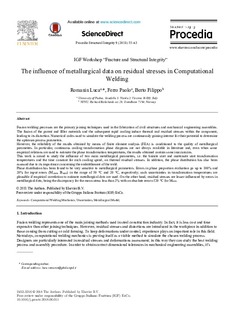| dc.contributor.author | Romanin, Luca | |
| dc.contributor.author | Ferro, Paolo | |
| dc.contributor.author | Berto, Filippo | |
| dc.date.accessioned | 2018-12-11T12:03:35Z | |
| dc.date.available | 2018-12-11T12:03:35Z | |
| dc.date.created | 2018-11-26T13:42:06Z | |
| dc.date.issued | 2018 | |
| dc.identifier.issn | 2452-3216 | |
| dc.identifier.uri | http://hdl.handle.net/11250/2577117 | |
| dc.description.abstract | Fusion welding processes are the primary joining techniques used in the fabrication of civil structures and mechanical engineering assemblies. The fusion of the parent and filler materials and the subsequent rapid cooling induce thermal and residual stresses within the component, leading to its distortion. Numerical codes used to simulate the welding process are continuously gaining interest for their potential to determine the optimum process parameters.
However, the reliability of the results obtained by means of finite element analysis (FEA) is conditioned to the quality of metallurgical parameters. In particular, continuous cooling transformation phase diagrams are not always available in literature and, even when some empirical relations are used to estimate the phase transformation temperatures, the results obtained contain some inaccuracies.
This work is aimed to study the influence of two main metallurgical parameters, i.e. the bainite start and martensite start transformation temperatures and the time constant for each cooling speed, on thermal residual stresses. In addition, the phase distribution has also been assessed due to its importance concerning the embrittlement of the weld.
Phase distribution has been found to be very sensitive to metallurgical parameters. Errors in phase proportion evaluation go up to 100% and 20% for input errors (Mstart, Bstart) in the range of 50 °C and 20 °C, respectively; such uncertainties in transformation temperatures are plausible if empirical correlation to estimate metallurgical data are used. On the other hand, residual stresses are lesser influenced by errors in metallurgical data, being the discrepancy for the mean stress less than 2% with an absolute error of 20 °C for Mstart. | nb_NO |
| dc.language.iso | eng | nb_NO |
| dc.publisher | Elsevier | nb_NO |
| dc.rights | Attribution-NonCommercial-NoDerivatives 4.0 Internasjonal | * |
| dc.rights.uri | http://creativecommons.org/licenses/by-nc-nd/4.0/deed.no | * |
| dc.title | The influence of metallurgical data on residual stresses in Computational Welding | nb_NO |
| dc.type | Journal article | nb_NO |
| dc.description.version | publishedVersion | nb_NO |
| dc.source.journal | Procedia Structural Engineering | nb_NO |
| dc.identifier.doi | 10.1016/j.prostr.2018.06.011 | |
| dc.identifier.cristin | 1635132 | |
| dc.description.localcode | © 2018 The Author(s). Published by Elsevier B.V. CC-BY-NC-ND 4.0 license http://creativecommons.org/licenses/by-nc-nd/4.0/ | nb_NO |
| cristin.unitcode | 194,64,92,0 | |
| cristin.unitname | Institutt for maskinteknikk og produksjon | |
| cristin.ispublished | true | |
| cristin.fulltext | original | |

